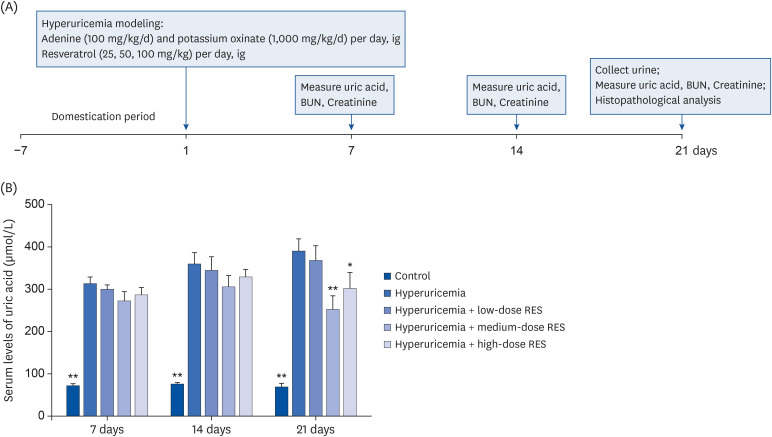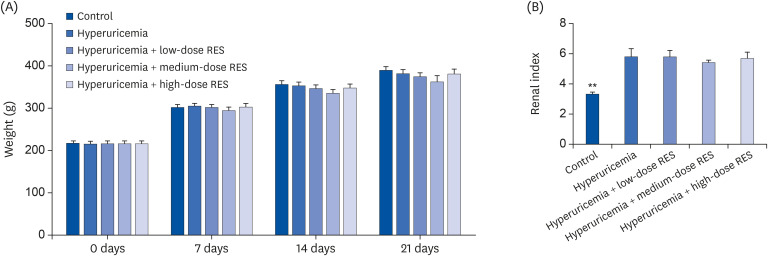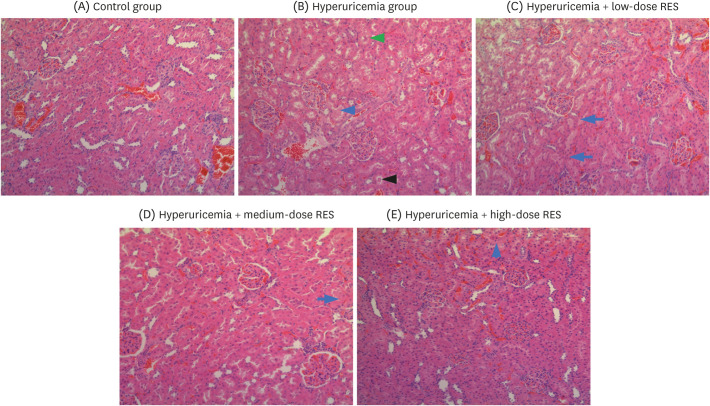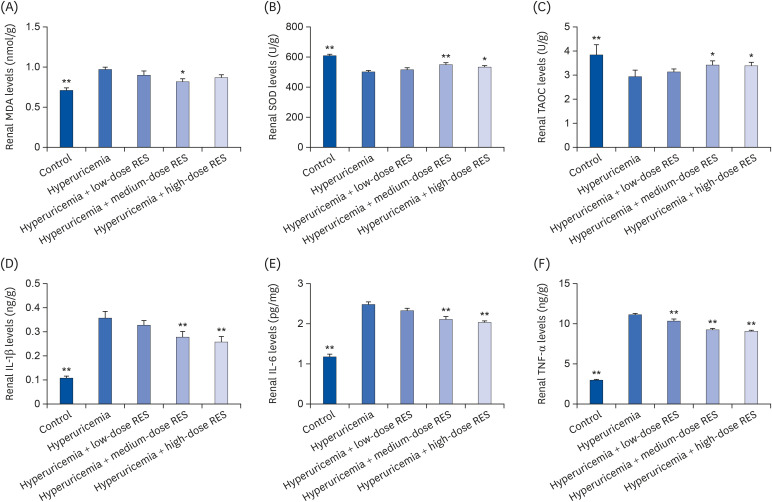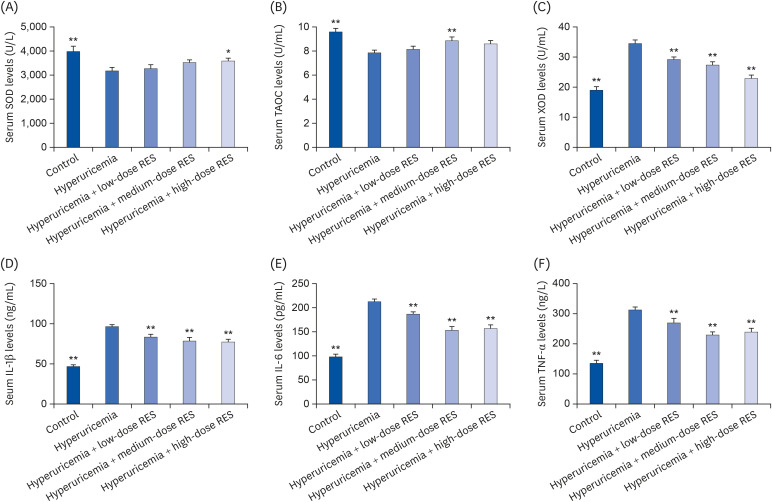Nutr Res Pract.
2021 Feb;15(1):26-37. 10.4162/nrp.2021.15.1.26.
Effects of resveratrol on the inflammatory response and renal injury in hyperuricemic rats
- Affiliations
-
- 1Department of Nutrition, Guangdong Provincial People's Hospital, Guangdong Academy of Medical Sciences, Guangzhou 510080, China
- 2Department of Nutrition, School of Public Health in Sun Yat-sen University, Guangzhou 510080, China
- KMID: 2511671
- DOI: http://doi.org/10.4162/nrp.2021.15.1.26
Abstract
- BACKGROUND/OBJECTIVES
Hyperuricemic nephropathy is a common cause of acute kidney injury. Resveratrol can ameliorate kidney injury, but the explicit mechanism remains unclear. We investigated the effects of resveratrol on the inflammatory response and renal injury in hyperuricemic rats.
MATERIALS/METHODS
A rat model of hyperuricemic nephropathy was established by the oral administration of a mixture of adenine and potassium oxinate. Biochemical analysis and hematoxylin and eosin staining were performed to assess the rat kidney function. Enzymelinked immunosorbent assays were performed to evaluate the immune and oxidative responses.
RESULTS
The expression levels of urine albumin and β2-microglobulin were significantly decreased after resveratrol treatment. In addition, the levels of serum creatinine and uric acid were significantly decreased in the resveratrol groups, compared with the control group.The levels of proinflammatory factors, such as interleukin-1β and tumor necrosis factor-α, in kidney tissue and serum were also increased in the hyperuricemic rats, and resveratrol treatment inhibited their expression. Moreover, the total antioxidant capacity in kidney tissue as well as the superoxide dismutase and xanthine oxidase levels in serum were all decreased by resveratrol treatment.
CONCLUSIONS
Resveratrol may protect against hyperuricemic nephropathy through regulating the inflammatory response.
Figure
Reference
-
1. Adedeji AO, Pourmohamad T, Chen Y, Burkey J, Betts CJ, Bickerton SJ, Sonee M, McDuffie JE. Investigating the value of urine volume, creatinine, and cystatin C for urinary biomarkers normalization for drug development studies. Int J Toxicol. 2019; 38:12–22. PMID: 30673360.
Article2. Fidan C, Kantar A, Baskın E, Gülleroğlu K, Akdur A, Moray G, Haberal M. Effects of hyperuricemia on renal function in pediatric renal transplant recipients. Exp Clin Transplant. 2015; 13 Suppl 1:247–250.3. Ghei M, Mihailescu M, Levinson D. Pathogenesis of hyperuricemia: recent advances. Curr Rheumatol Rep. 2002; 4:270–274. PMID: 12010614.
Article4. Lim AY, Teng GG. Allopurinol: a necessary evil. Singapore Med J. 2009; 50:925–926. PMID: 19787189.5. Zhang W, Chen H, Sun C, Wu B, Bai B, Liu H, Shan X, Liang G, Zhang Y. A novel resveratrol analog PA19 attenuates obesity‑induced cardiac and renal injury by inhibiting inflammation and inflammatory cell infiltration. Mol Med Rep. 2019; 19:4770–4778. PMID: 31059027.
Article6. Pan QR, Ren YL, Zhu JJ, Hu YJ, Zheng JS, Fan H, Xu Y, Wang G, Liu WX. Resveratrol increases nephrin and podocin expression and alleviates renal damage in rats fed a high-fat diet. Nutrients. 2014; 6:2619–2631. PMID: 25025298.
Article7. Kitada M, Koya D. Renal protective effects of resveratrol. Oxid Med Cell Longev. 2013; 2013:568093. PMID: 24379901.
Article8. Shi YW, Wang CP, Liu L, Liu YL, Wang X, Hong Y, Li Z, Kong LD. Antihyperuricemic and nephroprotective effects of resveratrol and its analogues in hyperuricemic mice. Mol Nutr Food Res. 2012; 56:1433–1444. PMID: 22865646.
Article9. Kitada M, Kume S, Imaizumi N, Koya D. Resveratrol improves oxidative stress and protects against diabetic nephropathy through normalization of Mn-SOD dysfunction in AMPK/SIRT1-independent pathway. Diabetes. 2011; 60:634–643. PMID: 21270273.
Article10. Chen YH, Fu YC, Wu MJ. Does resveratrol play a role in decreasing the inflammation associated with contrast induced nephropathy in rat model? J Clin Med. 2019; 8:147.
Article11. Wu M, Gu J, Mei S, Xu D, Jing Y, Yao Q, Chen M, Yang M, Chen S, Yang B, Qi N, Hu H, Wüthrich RP, Mei C. Resveratrol delays polycystic kidney disease progression through attenuation of nuclear factor κB-induced inflammation. Nephrol Dial Transplant. 2016; 31:1826–1834. PMID: 27190325.
Article12. Huang DD, Shi G, Jiang Y, Yao C, Zhu C. A review on the potential of Resveratrol in prevention and therapy of diabetes and diabetic complications. Biomed Pharmacother. 2020; 125:109767. PMID: 32058210.
Article13. Den Hartogh DJ, Tsiani E. Health benefits of resveratrol in kidney disease: evidence from in vitro and in vivo studies. Nutrients. 2019; 11:11.14. Baur JA, Sinclair DA. Therapeutic potential of resveratrol: the in vivo evidence. Nat Rev Drug Discov. 2006; 5:493–506. PMID: 16732220.15. Zhu W, Pang M, Dong L, Huang X, Wang S, Zhou L. Anti-inflammatory and immunomodulatory effects of iridoid glycosides from Paederia scandens (LOUR.) MERRILL (Rubiaceae) on uric acid nephropathy rats. Life Sci. 2012; 91:369–376. PMID: 22910180.16. Chen L, Yang S, Zumbrun EE, Guan H, Nagarkatti PS, Nagarkatti M. Resveratrol attenuates lipopolysaccharide-induced acute kidney injury by suppressing inflammation driven by macrophages. Mol Nutr Food Res. 2015; 59:853–864. PMID: 25643926.
Article17. Luo CJ, Luo F, Bu QD, Jiang W, Zhang W, Liu XM, Che L, Luan H, Zhang H, Ma RX, Sun JP, Xu Y. Protective effects of resveratrol on acute kidney injury in rats with sepsis. Biomed Pap Med Fac Univ Palacky Olomouc Czech Repub. 2020; 164:49–56. PMID: 30994109.
Article18. Wang N, Mao L, Yang L, Zou J, Liu K, Liu M, Zhang H, Xiao X, Wang K. Resveratrol protects against early polymicrobial sepsis-induced acute kidney injury through inhibiting endoplasmic reticulum stress-activated NF-κB pathway. Oncotarget. 2017; 8:36449–36461. PMID: 28430592.
Article19. Gan Y, Tao S, Cao D, Xie H, Zeng Q. Protection of resveratrol on acute kidney injury in septic rats. Hum Exp Toxicol. 2017; 36:1015–1022. PMID: 27837177.
Article20. Wang Y, Feng F, Liu M, Xue J, Huang H. Resveratrol ameliorates sepsis-induced acute kidney injury in a pediatric rat model via Nrf2 signaling pathway. Exp Ther Med. 2018; 16:3233–3240. PMID: 30214546.
Article21. Bekpinar S, Karaca E, Yamakoğlu S, Alp-Yıldırım FI, Olgac V, Uydes-Doğan BS, Cibali E, Gultepe S, Uysal M. Resveratrol ameliorates the cyclosporine-induced vascular and renal impairments: possible impact of the modulation of renin-angiotensin system. Can J Physiol Pharmacol. 2019; 97:1115–1123. PMID: 31613143.
Article22. Xue HY, Yuan L, Cao YJ, Fan YP, Chen XL, Huang XZ. Resveratrol ameliorates renal injury in spontaneously hypertensive rats by inhibiting renal micro-inflammation. Biosci Rep. 2016; 36:e00339. PMID: 27129290.
Article23. Smith NC, Christian SL, Taylor RG, Santander J, Rise ML. Immune modulatory properties of 6-gingerol and resveratrol in Atlantic salmon macrophages. Mol Immunol. 2018; 95:10–19. PMID: 29367081.
Article24. Erkasap S, Erkasap N, Bradford B, Mamedova L, Uysal O, Ozkurt M, Ozyurt R, Kutlay O, Bayram B. The effect of leptin and resveratrol on JAK/STAT pathways and Sirt-1 gene expression in the renal tissue of ischemia/reperfusion induced rats. Bratisl Lek Listy (Tlacene Vyd). 2017; 118:443–448.
Article25. Li J, Li L, Wang S, Zhang C, Zheng L, Jia Y, Xu M, Zhu T, Zhang Y, Rong R. Resveratrol alleviates inflammatory responses and oxidative stress in rat kidney ischemia-reperfusion injury and H2O2-Induced NRK-52E Cells via the Nrf2/TLR4/NF-κB Pathway. Cell Physiol Biochem. 2018; 45:1677–1689. PMID: 29490296.26. Bienholz A, Mae Pang R, Guberina H, Rauen U, Witzke O, Wilde B, Petrat F, Feldkamp T, Kribben A. Resveratrol does not protect from ischemia-induced acute kidney injury in an in vivo rat model. Kidney Blood Press Res. 2017; 42:1090–1103. PMID: 29207388.27. He T, Guan X, Wang S, Xiao T, Yang K, Xu X, Wang J, Zhao J. Resveratrol prevents high glucose-induced epithelial-mesenchymal transition in renal tubular epithelial cells by inhibiting NADPH oxidase/ROS/ERK pathway. Mol Cell Endocrinol. 2015; 402:13–20. PMID: 25540919.
Article28. Wang Y, Wang B, Qi X, Zhang X, Ren K. Resveratrol protects against post-contrast acute kidney injury in rabbits with diabetic nephropathy. Front Pharmacol. 2019; 10:833. PMID: 31402864.
Article29. Ramalingam A, Santhanathas T, Shaukat Ali S, Zainalabidin S. Resveratrol supplementation protects against nicotine-induced kidney injury. Int J Environ Res Public Health. 2019; 16:16.
Article30. Hall S, Dixit M, Arany I. Resveratrol attenuates nicotine-mediated oxidative injury by inducing manganese superoxide dismutase in renal proximal tubule cells. In Vivo. 2017; 31:551–555. PMID: 28652419.31. Soussi D, Danion J, Baulier E, Favreau F, Sauvageon Y, Bossard V, Matillon X, Turpin F, Belgsir EM, Thuillier R, Hauet T. Vectisol formulation enhances solubility of resveratrol and brings its benefits to kidney transplantation in a preclinical porcine model. Int J Mol Sci. 2019; 20:2268.
Article32. Ibrahim A, Al-Hizab FA, Abushouk AI, Abdel-Daim MM. Nephroprotective effects of benzyl isothiocyanate and resveratrol against cisplatin-induced oxidative stress and inflammation. Front Pharmacol. 2018; 9:1268. PMID: 30524274.
Article33. Cigremis Y, Akgoz M, Ozen H, Karaman M, Kart A, Gecer M, Atalan G. Resveratrol ameliorates cisplatin-induced oxidative injury in New Zealand rabbits. Can J Physiol Pharmacol. 2015; 93:727–735. PMID: 26243022.
Article34. Denek Z, Erbil G, Ozbal S, Micili SC, Ozogul C. The effects of resveratrol against trifluralin toxicity in the urinary tract of rats. Toxicol Ind Health. 2016; 32:106–117. PMID: 24021433.
Article35. Al Dera HS. Protective effect of resveratrol against aluminum chloride induced nephrotoxicity in rats. Saudi Med J. 2016; 37:369–378. PMID: 27052279.
- Full Text Links
- Actions
-
Cited
- CITED
-
- Close
- Share
- Similar articles
-
- Effects of Resveratrol Supplementation on Oxidative Damage and Lipid Peroxidation Induced by Strenuous Exercise in Rats
- The expression patterns of nitric oxide synthases (NOS) by resveratrol in hypoxic-ischemic brain injury in neonatal rat model
- Impaired Naâºâˆ’Kâº-ATPase signaling in renal proximal tubule contributes to hyperuricemia-induced renal tubular injury
- Flow Cytometric Analysis of the Effects of Resveratrol on the Survival of Human Tennon's Capsule Fibroblasts
- Resveratrol promotes mitochondrial energy metabolism in exerciseinduced fatigued rats

